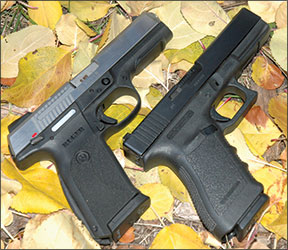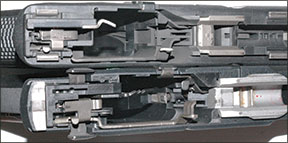On our plate this month are two fairly big pistols. They are an old standby, the Glock 21 (about $600), and a newer Ruger SR45 with an MSRP of $529. Both were big, hand-filling handguns, capable of packing a devastating punch with anything from classic 230-grain hardball to the lightest-weight, super-expanding bullets. The Glock magazine held 13 rounds and the Ruger held 10. These larger-than-normal capacities gave the guns sizeable grips. The Glock offered the shooter a caved-in back strap to help get your hand around it, and the Ruger resorted to thin side panels. Both guns had polymer frames and steel slides. It looked to us like Ruger copied the Glocks trigger, but added an ambidextrous safety. The Glock 21 had only its trigger safety, which has proven effective for a long time now. We tested the two guns with Winchester 185-grain BEB, Lawman 230-grain hardball, and with Cor-Bon 185-grain jacketed hollowpoints.

Both guns came with loading-assist devices that slip over the magazines. We didnt find them necessary with the normal magazines for either gun, but on the 26-round extended magazine that came with the Glock, wed have used it if we wanted to fully fill that long thing. Here is what we found.
Glock 21 Gen 3 45 ACP, $600
Glock guns tend to look a lot alike. If youve seen one, you have a good idea what the others look like. All the Glocks have squared-off slides, blocky profiles, matte-black finish, the trick trigger with built-in safety, and a minimum of controls other than that trigger. Bigger calibers are bigger guns. In the case of the Model 21, its a pretty big package. With 13 rounds of 45 ACP on tap, the grip is, as you might guess, on the huge side. In fact its so much so that wed guess those with average or small hands would reject it.
The grip has a hollow area that might help some get a solid grasp on the gun. We thought it felt quite horrid compared to the similar styling of the 40-caliber Glock Model 23. In the case of this G21, it does not have alternate grip inserts. What you see is what you get. There is a Gen 4 model that costs more and has interchangeable back straps, and if you like the gun but not its grip, you might give the Gen 4 model a look.
Prices for Glocks vary with availability. As this is written weve seen a G21 offered for less than $540, and some for more than $600. Our test gun had night sights, which add about $40 or $50 to the cost. Our test unit was solidly made, slightly lighter than the Ruger, and like most Glocks, set up primarily for right-handers. The Ruger was a touch more ambi with its two-side safety. Lefties would have to use the index finger to get the slide-drop button and the magazine release on the Glock. The finger grooves fit our hands well enough, though some might like to see Glocks without those grooves.
The sight picture with the Glocks steel sights is slightly wider than that of the Ruger, and thus a bit faster. Three glowing green dots, or three off-white buttons, is what the shooter sees, depending on ambient light.
Takedown is pure Glock simplicity. Clear the gun, pull back slightly on the slide while pulling downward on the two finger-grip releases just above the trigger. Release the slide, press the trigger, and off comes the slide with its barrel and spring. The spring, like the Rugers, is captive. In fact, the insides of the two slides reveal many more similarities than do the outsides of the two guns. This is not necessarily bad, but is indeed a reflection of the excellence and general worth of the much older Glock design.

Inside, everything looked robust and well thought out. The inside of the Glock frame again showed the similarity of the Rugers design, we noticed, with the guts of the two guns being strikingly alike. Putting the Glock back together is one of the simplest processes in the industry. Stick the barrel into the slide, slip the spring – which only goes in one way – into place, slide the slide onto the frame and give it a tug toward the back, and youre done. Apart, the Glock has just five big pieces, none easily lost. Ruger has six, one of them small and critical. Score one for Glock.
On the range, the Glock performed perfectly. Recoil was there, but it wasnt too much for a seasoned 45 shooter. Accuracy was on par with the Ruger, and the Glock actually worked with all the test ammo.
Our Team Said: The Glocks price is slightly higher than the Rugers, and some shopping around looks like it would pay big dividends if you want a Model 21 in your holster at the best price. One good thing – it looks like the Glock will always work, even if its not the smallest, easiest-carried 45 out there.
Ruger SR45 45 ACP, $529
Our first look at the Ruger gave us the impression the gun was pretty handy for a high-capacity 45 auto. The two-tone finish was mighty attractive and, as with most Ruger products, very well done. The gun was big and heavy, but didnt feel top heavy or the least bit clumsy. Score one for Ruger.
With slightly less stagger to its magazine, the Ruger had a grip that was thinner than the Glocks. We found the Rugers grip to be the more comfortable of the two. The grip angle is similar to that of a 1911 45 auto, so we felt right at home with it. The barrel sat lower in the hand than a 1911, and the rear strap of the Ruger had a rubber insert that helped give the hand an easy ride. The side and front panels had fine checkering molded in, and the checkering worked okay.
For sights, the Ruger SR45 had sturdy steel inserts slipped into dovetails. A surprise was the rear was adjustable for elevation. Windage would have to be adjusted by drifting the front or rear. There were three white dots. The top of the slide held an indicator that popped up when a round was in the chamber. (On the Glock, the extractor protrudes slightly with a loaded chamber.) The sharp edges of the slide and of the entire gun were smoothed to ease holster insertion and give the hands an easy time during clearance drills.
Takedown was a slick and easy system. Lock the slide back on a cleared gun, push a protected pin on the right side over toward the left, and then remove the takedown plate from the left side. Ease the slide down, press the trigger, and pull the slide off the front. Take out the spring and the barrel, and youre there. Reversal required a trick. The trigger bar will stick up too far if you mess with the trigger when the gun is apart. If thats the case, pull the trigger bar slightly forward, and itll get slightly lower in the frame, allowing reassembly. Lock the slide back again, slip in the takedown plate, and youre done. That was as fine a takedown system as weve seen.
One glitch we didnt like was that once the slide was locked back, you could not insert a fresh magazine and simply press down on the slide stop to chamber a round. You had to pull the slide back and let it fly forward. Those of us with serious training in personal-defense handguns will not like that feature. Except for that item, we liked what we saw on the big Ruger. Then we took it to the range.
Our first shots were with Winchesters 185-grain BEB ammo, which has proven to be a fine, reliable, and accurate round in a good many guns. The Ruger would not reliably fire them. Most of the time the primers were barely dented, and we had many, many iterations of that failure. However, the other two types of ammo fired perfectly, and the Rugers accuracy was good enough. It got 3.4 inches on average at 15 yards with hardball, and 1.6 inches with the hot Cor-Bon 185-grain JHP. The accuracy was on a par with that of the Glock, but we had to fail the Ruger because of its problem with Winchester ammo.
Of course we dont know what other brands of ammunition would fail, but when a solid, reliable round by a major maker like Winchester doesnt work, we cant recommend the gun.
The firing pin spring felt strong, and we found no significant dirt in the gun that might have clogged anything. However, on inspecting it we found a surprise. We tested this by putting a pencil down the bore of a cleared gun – no ammo anywhere near it. Then we pointed the gun at the ceiling and pulled the trigger. The firing pin strike propels the pencil out of the gun. This is a good way to check for how hard the strike is, and with practice, you know what works and what doesnt.
If the Rugers magazine is removed, the trigger breaks, but the gun wont fire. The pencil goes nowhere. If we then put the magazine in, the pencil would be just barely propelled out the muzzle. Occasionally, the pencil would be launched higher than the Glock propelled it, but most of the time this interlocking system with the magazine seemed to be preventing the gun from working as it is supposed to.
Our Team Said: Although we liked the gun, we would not buy it until Ruger has eliminated the non-firing option when the magazine is removed. We strongly agree with one of our test crew who observed that Rugers trying to make a gun too safe could get its owner killed.
Written and photographed by Ray Ordorica, usingevaluations from Gun Tests team testers. GT





























